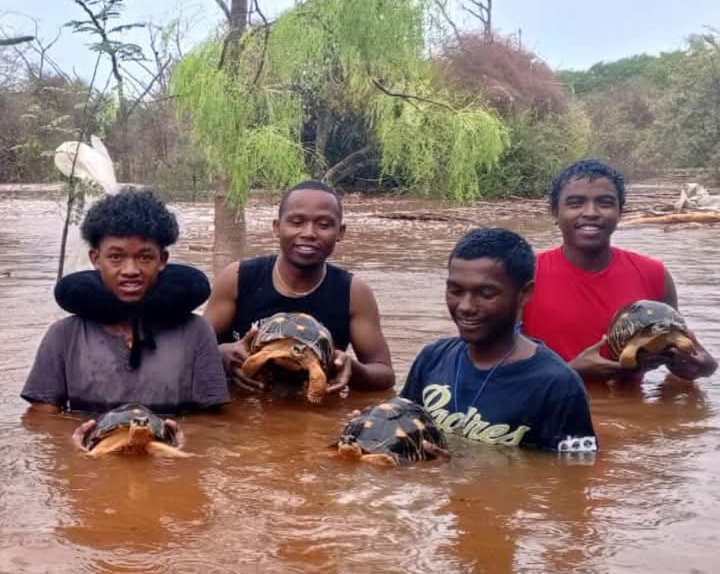
By Adeyemi Adekunle
In a remote corner of southern Madagascar, a crisis of epic proportions unfolded in mid-January when Cyclone Dikeledi struck, flooding the region and wreaking havoc on one of the world’s most crucial wildlife sanctuaries. The Lavavolo Tortoise Center, home to 12,000 critically endangered radiated and spider tortoises rescued from illegal wildlife traffickers, was submerged under a metre of water as torrential rains pounded the area.
The once-safe haven became a scene of chaos as the tortoises, already victims of human exploitation, were now swept into the currents, their survival hinging on a community’s courage and determination.
As floodwaters consumed the sanctuary, staff at Lavavolo sounded the alarm. With little time to spare, members of the local community and even police officers joined forces in what would become a heroic rescue operation. Despite losing homes and belongings to the cyclone themselves, these villagers did not hesitate. Equipped with large containers, makeshift tools, and a profound respect for the vulnerable reptiles, they waded into the murky waters, determined to save each tortoise they could find.
For many in the community, these tortoises were more than just animals. Radiated and spider tortoises are iconic species in Madagascar, deeply connected to the country’s unique biodiversity and often revered as symbols of resilience and endurance. The sight of these creatures floundering in the floodwater sparked a collective sense of responsibility that transcended individual struggles. “We couldn’t just let them die,” said a sanctuary worker who had been waist-deep in water for hours. “They’ve already been through so much. This is their sanctuary—we owed it to them to fight for their lives.”
The rescue effort was a display of both ingenuity and grit. Damaged building materials from the sanctuary were repurposed into rafts to ferry groups of tortoises to higher ground. Villagers formed human chains, carefully passing the reptiles to safety. Others ventured deeper into the waters, navigating debris and strong currents to locate tortoises that had been carried further away. For some, the task took on a spiritual significance, with elders praying as they worked, calling on ancestral blessings to aid their efforts.
Children joined in as well, collecting the smaller tortoises that had clung to shrubs or floated near the sanctuary’s perimeter. In some moments, the scene was both heartbreaking and hopeful—a blend of destruction and the unyielding human spirit. “You could see their tiny legs moving in panic,” said one young boy who helped guide tortoises onto a makeshift raft. “I just thought, ‘We have to help them keep moving.’”
The operation spanned days. With food supplies low and exhaustion setting in, many rescuers refused to leave the flooded sanctuary, subsisting on whatever they could find. Volunteers with farming experience even began gathering grass and leaves to feed the rescued tortoises. “It’s not just about pulling them out of the water,” a local farmer said. “It’s about keeping them alive once we do.”
Among the rescuers was a local police officer who had seen firsthand the devastation caused by illegal wildlife trafficking. He worked tirelessly alongside others, understanding how precious these tortoises were—not just to the ecosystem but to global conservation efforts. “When you see their resilience, you realize they’re not just animals,” he said. “They’re survivors. And now it’s our duty to ensure they continue surviving.”
The Lavavolo Tortoise Center has long been a beacon of hope in Madagascar’s fight against illegal wildlife trade. Radiated and spider tortoises are prized on the black market, where their intricate shell patterns fetch high prices. The sanctuary had become a safe space for these animals, many of which had endured unimaginable suffering before being rescued. The thought of losing them to natural disaster was unthinkable for the community, which has worked hand-in-hand with conservation organizations to protect their unique biodiversity.
In the aftermath of the cyclone, the toll became clear: many tortoises were injured, and a few had succumbed to the chaos, but the overwhelming majority had survived thanks to the collective effort. The sanctuary itself suffered extensive damage, with buildings reduced to rubble and infrastructure needing urgent repair. Despite the challenges ahead, the spirit of unity and resilience in the face of adversity stood out as a beacon of hope.
As the waters receded, the rescued tortoises were relocated to temporary enclosures while plans for reconstruction began. The sanctuary staff, now joined by more volunteers, continued caring for the animals, providing medical attention to the injured and ensuring they had a stable environment. International conservation groups have pledged to support the rebuilding process, inspired by the community’s extraordinary efforts.
For the people of southern Madagascar, this wasn’t just a story of rescuing animals. It was a reaffirmation of the deep bond between humans and nature, a testament to how a crisis can bring out the best in humanity. The tortoises, fragile yet enduring, became symbols of hope and perseverance.
“We saved them because it was the right thing to do,” said one rescuer, looking over the sanctuary’s temporary enclosures. “They depend on us, but I think we depend on them too—to remind us of what it means to survive.”




